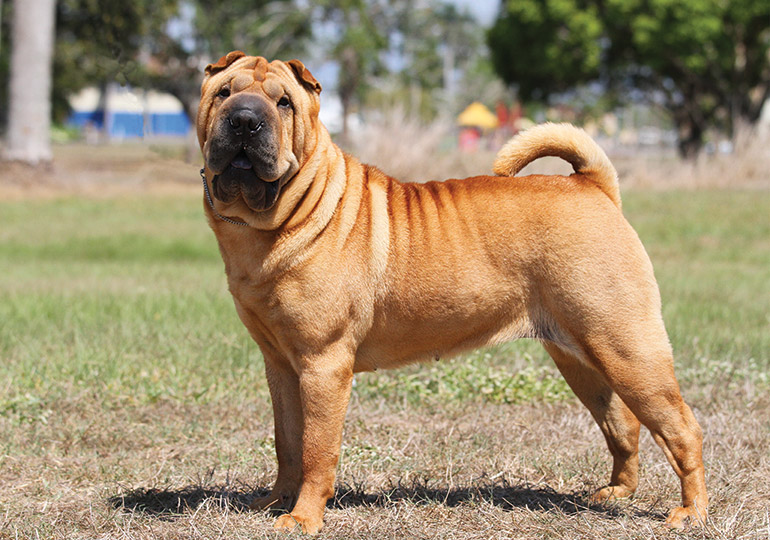Breeds
Shar Pei

GROUP 7 - NON SPORTING
History
The Shar Pei has been identified as a basal breed that predates the emergence of the modern breeds in the 19th century. According to historical documents and artifacts, it has existed in China since ancient times, and its likeness was often used to decorate various objects, especially during the Han Dynasty. During this period, it was used for many tasks including hunting, herding and protection and in later years as a fighting dog, gradually becoming a favourite pet of Chinese emperors. The Shar Pei continues to be trained as a fighting dog in modern-day Tibet.
The Shar Pei breed comes from the Guangdong province of China. The original Shar Pei from China looked very different from the breed now popular in the West. People in southern China, Hong Kong, and Macau differentiate the Western type and the original type, by calling them respectively ‘meat-mouth’ and ‘bone-mouth’ Shar Pei.
Appearance
A squarely built, medium sized, compact dog the Shar Pei’s most distinctive feature would arguably be its wrinkled appearance. Although more prominent as puppies, these wrinkles should lessen as they grow, so as to only appear over the shoulders, on the head and at the base of the tail. Their ears are small, thick and triangular in shape, set high but well apart and should point toward the eye. The eye is deep set and its function must never be impeded by the surrounding skin. Excessive skin on the body and legs is strongly discouraged. With the bottom jaw appearing to be wider that the top, a Shar Pei’s muzzle, when viewed from the front, should resemble the shape of a hippopotamus head. The padding of the muzzle and jaw must not obstruct a correct bite.
“Shar Pei” is thought to be translated to “Sand Skin,” depicting the harsh coat that can be described as “Needles in Cotton”. There are two coat types in the Shar Pei; the shorter harsher “Horse Coat” and the longer, softer “Brush Coat”. However the coat length should not exceed 2.5cm. The tail is rounded, narrowing to a point, set very high and carried over the back when alert or on the move. Paws should be well arched and strong.
Health
A thoughtfully bred Shar Pei should have few health issues, however they can be prone to skin conditions, entropion and “yeasty” ears. Musculoskeletal abnormalities are uncommon in the Shar Pei. Shar Pei Autoinflammatory Disease (SPAID) is of particular concern for the breed as affected dogs often live short lives that end tragically. A new test may soon be available in Australia to assist in limiting the ongoing manifestation of this disease.
Temperament
In general the Shar Pei is a loyal, devoted and affectionate family member. It can be suspicious of strangers, but should be accepting of people when introduced by someone they trust. They respond well to calm, friendly reward based training and have been seen engaging in a number of dog activities including agility, nose works and lure coursing.
They are generally protective of their space and take offence to intruders. Due to their frowning expression and deep set eyes they can often be “misread” by other dogs.
Suitability
Being a rather adaptable breed, the Shar Pei is suited to most lifestyles. It is just as at home sitting on the sofa with their favourite human, or climbing a mountain with you. They are naturally clean in the home and are not generally destructive, making them a perfect apartment dog.
They do moult as with most breeds, but their short coat is not overly intrusive. People with sensitive skin may have a reaction to the shorter harsh “Horse coat.”
Shar Pei can be ‘bossy’ with other dogs and need early socialisation and ongoing training to remind them of their manners. Shar Pei love their family and will protect vulnerable members if the need arises.
Words: Dianne Gooding
Image supplied by Dianne Gooding
In Conclusion
Now you know a little about the Shar Pei, you may think that this is the dog for you. Before you make a decision, please make contact with the breed club or your State controlling body for purebred dogs. They will be able to give you information about available puppies and also suggest dog shows where you can see the breed and speak to breeders. In this way you will gain a better perspective of the Shah Pei and its needs, and whether this breed would suit your lifestyle.
Breeders
Sorry, there are currently no breeders advertising for this breed. If you are a registered Dogs SA breeder and wish to advertise here please create an advertisement here.

